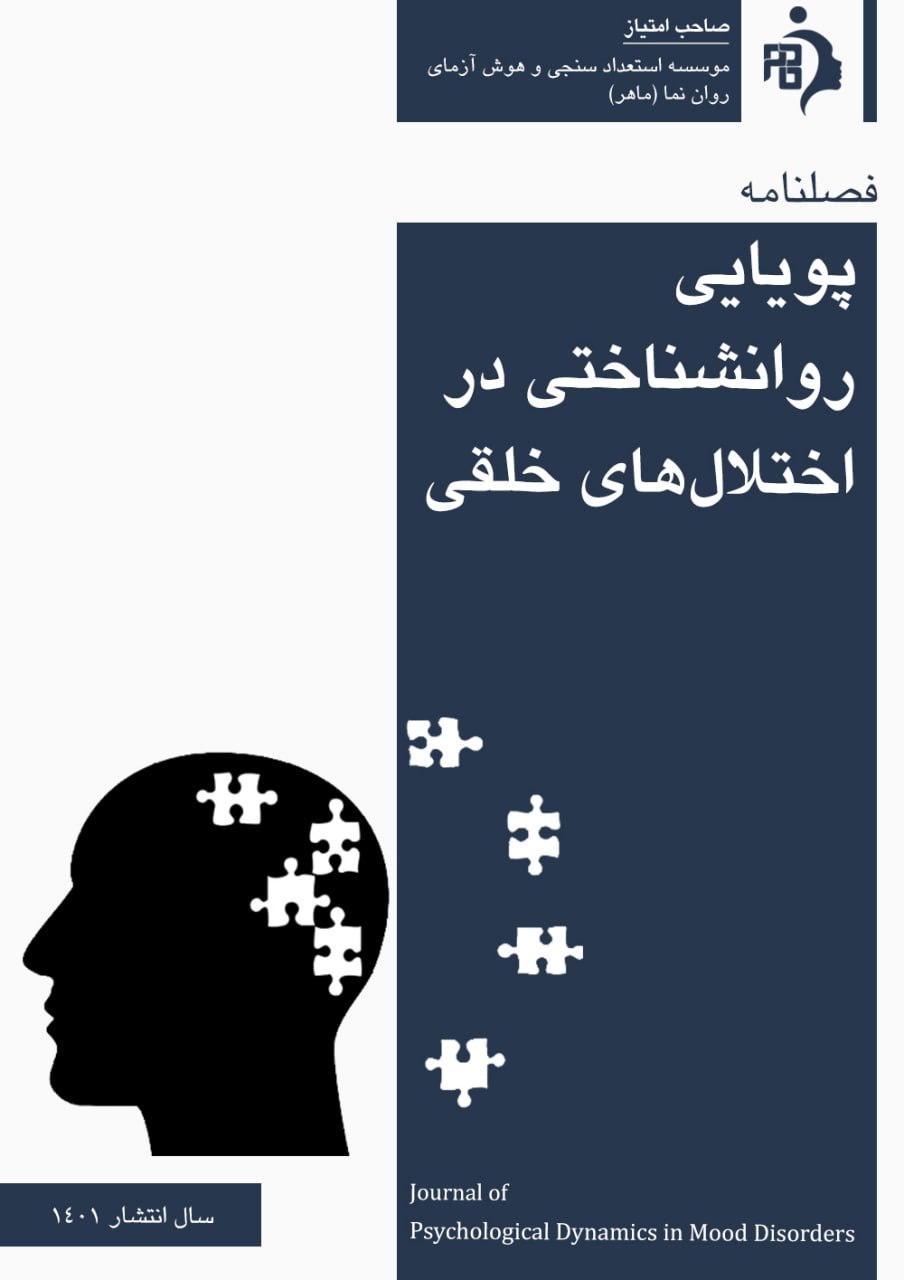Psychometric Properties of the Breakup Distress Scale in Students
Keywords:
romantic breakup, breakup distress scale, reliability, validityAbstract
Objective: The present study aims to determine the psychometric properties of the Breakup Distress Scale (BDS).
Methodology: This study is a cross-sectional descriptive correlational research. The statistical population included all students with breakup experiences in the city of Sari, from which 406 students were selected as the sample through convenience sampling. The tools used in this study were the Breakup Distress Scale (BDS), the Love Trauma Inventory (LTI), the Cognitive Emotion Regulation Questionnaire 18-item version (CERQ-18), the Acceptance and Action Questionnaire 10-item version (AAQ-II), and the 10-item Repetitive Thoughts Questionnaire (RTQ-10). Data were analyzed using SPSS software version 24, employing statistical methods including Cronbach's alpha, exploratory factor analysis, and Pearson correlation coefficient.
Findings: The results showed that the Breakup Distress Scale had a unidimensional structure and a high internal consistency coefficient of 0.94. Additionally, the test-retest reliability coefficient was found to be 0.81. Furthermore, this tool showed significant positive correlations with the Love Trauma Inventory, the Repetitive Thoughts Questionnaire, the maladaptive subscale of the Cognitive Emotion Regulation Questionnaire, and the emotional experience avoidance subscale of the Acceptance and Action Questionnaire. It also showed a significant negative correlation with the adaptive subscale of the Cognitive Emotion Regulation Questionnaire and the life control subscale of the Acceptance and Action Questionnaire, confirming its convergent and discriminant validity.
Conclusion: Based on the obtained results, it can be concluded that the Breakup Distress Scale appears to have good reliability and validity in the Iranian population and can serve as a useful tool for measuring the intensity of emotional distress caused by breakup.
Downloads
References
Akbari, M. (2017). Validation and Reliability of the 10-Item Repetitive Thinking Questionnaire in a Non-Clinical Sample: A Transdiagnostic Tool. Clinical Psychology, 9(2), 59-71. https://sid.ir/paper/152613/fa
Aliakbari Dehkordi, M., Ghafoori, S., Jafari, F., & Mohtashami, T. (2020). Effectiveness of Acceptance and Commitment Therapy (ACT) Training on Somatic Symptoms, Psychological Flexibility, and Social Health in Patients with Psoriasis. Knowledge and research in applied psychology, 21(4), 118-132. https://sid.ir/paper/398386/fa
Amanollahi, A., Tardast, K., & Aslani, K. (2014). Predicting Love Trauma Symptoms Based on Self-Compassion in Female Students with Emotional Breakup Experience. Applied Psychology Quarterly, 4(22), 43-61. https://apsy.sbu.ac.ir/article_96262_bc7edbb26020ec71f4f9d9a813a00f4c.pdf
Arana, F. G., Rice, K. G., & Aiello, M. (2024). A Cross-Cultural Look at the Role of Rumination in the Relationship Between Trait Anxiety and Romantic Breakup Distress. European Journal of Trauma & Dissociation, 8(1), 100376. https://doi.org/10.1016/j.ejtd.2023.100376
Babar, A., Nosheen, N., & Ahsan, L. (2024). Exploring the Effectiveness of Narrative Therapy Among Prolonged Grief Disorder. J. Asian Dev. Studies, 13(4), 66-81. https://doi.org/10.62345/jads.2024.13.4.5
Bryant, R. A. (2024). Cognitive Behavior Therapy vs Mindfulness in Treatment of Prolonged Grief Disorder. JAMA Psychiatry, 81(7), 646. https://doi.org/10.1001/jamapsychiatry.2024.0432
Champion, M. J., & Kilcullen, M. (2023). Complicated Grief Following the Traumatic Loss of a Child: A Systematic Review. OMEGA - Journal of Death and Dying. https://doi.org/10.1177/00302228231170417
Eisma, M. C., & Stroebe, M. S. (2021). Emotion Regulatory Strategies in Complicated Grief: A Systematic Review. Behavior therapy, 52(1), 234-249. https://doi.org/10.1016/j.beth.2020.04.004
Eisma, M. C., Tonus, D., & de Jong, P. J. (2022). Desired Attachment and Breakup Distress Relate to Automatic Approach of the Ex-Partner. Journal of Behavior Therapy and Experimental Psychiatry, 75, 101713. https://doi.org/10.1016/j.jbtep.2021.101713
Field, T., Diego, M., Pelaez, M., Deeds, O., & Delgado, J. (2010). Breakup Distress and Loss of Intimacy in University Students. Psychology, 1(3), 173. https://doi.org/10.4236/psych.2010.13023
Hsu, W. S., Chen, H. Y., & Chen, H. J. (2022). The Effectiveness of Solution-Focused Group Counseling for Taiwanese Unmarried Females' Post-Breakup Loss: A Pilot Study. Journal of Solution Focused Practices, 6(1), 6. https://doi.org/10.59874/001c.75001
Khanzadeh, M., Saeedian, M., Hosseini Chari, M., & Idrisi, F. (2012). Factor structure and psychometric properties of the emotional regulation difficulties scale. Journal of Behavioral Sciences, 6(1), 87-96. https://www.behavsci.ir/article_67768_01a5f82ae30d4cbf3dd322fd6618c7eb.pdf
Li, Y., Chan, W. C. H., & Marrable, T. (2023). "I never told my family I was grieving for my mom": The not‐disclosing‐grief experiences of parentally bereaved adolescents and young adults in Chinese families. Family Process. https://doi.org/10.1111/famp.12865
Loan, N. T., Minh, T. T. K., Truc, N. V. T., & My, T. T. H. (2023). The Mediating Role Of Rumination In Breakup Distress After Romantic Relationships And Sleep Disturbance Of The Students And A Five-Day-Proposed Intervention Program. Journal of Namibian Studies: History Politics Culture, 33, 1464-1496.
McEvoy, P. M., Mahoney, A. E., & Moulds, M. L. (2010). Are worry, rumination, and post-event processing one and the same?: Development of the Repetitive Thinking Questionnaire. Journal of anxiety disorders, 24(5), 509-519. https://doi.org/10.1016/j.janxdis.2010.03.008
Meyers, L. S., Gamst, G., & Guarino, A. J. (2013). Applied Multivariate Research: Design and Interpretation (2nd ed.). Sage Publications, Inc. https://www.amazon.com/Applied-Multivariate-Research-Design-Interpretation/dp/1506329764
Purwoko, B., & Fitriyah, F. (2018). Anger Management in Adolescents Behind Romantic Breakup: Implementation of Solution-Focused Brief Therapy. 1st International Conference on Education Innovation (ICEI 2017),
Rahmani, F., Hosseinzadeh, M., & Gholizadeh, L. (2023). Complicated Grief and Related Factors Among Nursing Staff During the Covid-19 Pandemic: A Cross-Sectional Study. BMC psychiatry, 23(1), 73. https://doi.org/10.1186/s12888-023-04562-w
Ratcliffe, M., Richardson, L., & Millar, B. (2023). On the Appropriateness of Grief to Its Object. Journal of the American Philosophical Association, 9(2), 318-334. https://doi.org/10.1017/apa.2021.55
Tang, S. (2024). Healing Grief – An Online Self-Help Intervention Programme for Bereaved Chinese With Prolonged Grief: Study Protocol for a Randomised Controlled Trial. European Journal of Psychotraumatology, 15(1). https://doi.org/10.1080/20008066.2024.2323422
Tavassoli, Z., Aghamohammadian Sharbaf, H. R., Sepehri Shamloo, Z., & Shahsavari, M. (2018). Effectiveness of Group Reality Therapy on Love Trauma Symptoms and General Functioning in Individuals with Emotional Breakup. Applied Psychology Quarterly, 12(1), 83-102. https://apsy.sbu.ac.ir/article/view/article_97040.html?lang=en
Verhallen, A. M., Renken, R. J., Marsman, J. B. C., & Ter Horst, G. J. (2019). Romantic Relationship Breakup: An Experimental Model to Study Effects of Stress on Depression (-Like) Symptoms. PLoS One, 14(5), e0217320. https://doi.org/10.1371/journal.pone.0217320
Williams, J. L., Hardt, M. M., Henschel, A. V., & Eddinger, J. R. (2019). Experiential Avoidance Moderates the Association Between Motivational Sensitivity and Prolonged Grief but Not Posttraumatic Stress Symptoms. Psychiatry research, 273, 336-342. https://doi.org/10.1016/j.psychres.2019.01.020
Zapata-Vega, D., Pichardo-Marte, C., Frías-Hiciano, M., Pacheco del Castillo, L., Espinal, J., & Garrido, L. E. (2022). Heartache in Young Adulthood: Cross-Cultural Adaptation and Validation of a Spanish Version of the Breakup Distress Scale. Emerging Adulthood, 10(3), 788-803. https://doi.org/10.1177/21676968221076340
Downloads
Published
Submitted
Revised
Accepted
Issue
Section
License
Copyright (c) 2025 Journal of Psychological Dynamics in Mood Disorders

This work is licensed under a Creative Commons Attribution-NonCommercial 4.0 International License.









